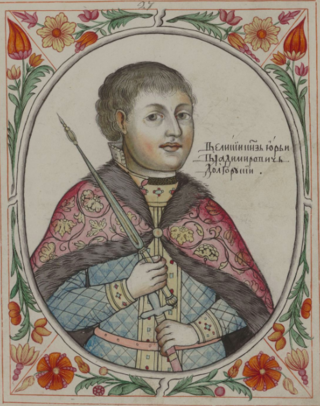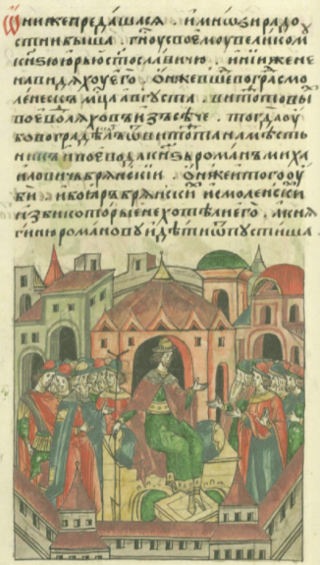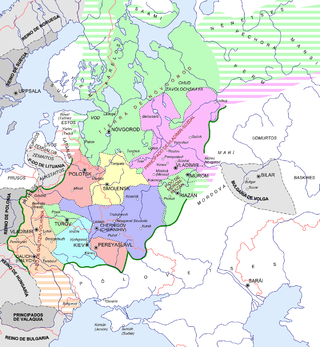
Smolensk is a city and the administrative center of Smolensk Oblast, Russia, located on the Dnieper River, 360 kilometers (220 mi) west-southwest of Moscow. First mentioned in 863, it is one of the oldest cities in Russia. It has a population of 316,570 (2021 Census).

Yuri I Vladimirovich, commonly known as Yuri Dolgorukiy or the Long Arm, was a Monomakhovichi prince of Rostov and Suzdal, acquiring the name Suzdalia during his reign. Noted for successfully curbing the privileges of the landowning boyar class in Rostov-Suzdal and his ambitious building programme, Yuri transformed this principality into the independent power that would evolve into early modern Muscovy. Yuri Dolgorukiy was the progenitor of the Yurievichi, a branch of the Monomakhovichi.
Rostislav Mstislavich was Prince of Smolensk (1125–1160), Novgorod (1154) and Grand Prince of Kiev. He is the progenitor of the Rostislavichi of Smolensk. He was the son of Mstislav I of Kiev and Christina Ingesdotter of Sweden.

Algirdas was Grand Duke of Lithuania from 1345 to 1377. With the help of his brother Kęstutis he created an empire stretching from the present Baltic states to the Black Sea and to within 80 kilometres of Moscow.

Mstislav Mstislavich the Daring, also called the Able, was a prince of Tmutarakan and Chernigov, one of the princes from Kievan Rus' in the decades preceding the Mongol invasions.

Yury Svyatoslavich or Georgy Svyatoslavovich was the last sovereign ruler of the Principality of Smolensk and Bryansk whose life was spent in vain attempts to fend off aggression by the Grand Duchy of Lithuania.
The Muscovite–Lithuanian Wars were a series of wars between the Grand Duchy of Lithuania, allied with the Kingdom of Poland, and the Grand Duchy of Moscow, which was later unified with other Russian principalities to eventually become the Tsardom of Russia. After several defeats at the hands of Ivan III and Vasily III, the Lithuanians were increasingly reliant on Polish aid, which eventually became an important factor in the creation of the Polish–Lithuanian Commonwealth. Before the first series of wars in the 15th century, the Grand Duchy of Lithuania controlled vast stretches of Eastern European land, from Kiev to Mozhaysk, following the collapse of Kievan Rus' after the Mongol invasions. Over the course of the wars, particularly in the 16th century, the Muscovites expanded their domain westwards, taking control of many principalities.

The inner Principality of Kiev was a medieval East Slavic state, situated in central regions of modern Ukraine around the city of Kiev.

The Battle of the Novogorodians with the Suzdalians was a 1169 siege of the city of Novgorod the Great, capital of the Novgorod Republic, during the 1167–1169 Kievan succession crisis.
Mstislav Rostislavich, known as "The Brave", was Prince of Smolensk and Prince of Novgorod.
The Prince of Pereyaslavl was the ruler of the Principality of Pereyaslavl, a lordship based on the city of Pereyaslavl on the Trubezh River, and straddling extensive territory to the east in what are now parts of Ukraine. It was situated on the southern frontier of Kievan Rus' and bordered the steppe.
The Prince of Smolensk was the kniaz, the ruler or sub-ruler, of the Rus' Principality of Smolensk, a lordship based on the city of Smolensk. It passed between different groups of descendants of Grand Prince Iaroslav I of Kiev until 1125, when following the death of Vladimir Monomakh the latter's grandson Rostislav Mstislavich was installed in the principality, while the latter's father Mstislav I Vladimirovich became Grand Prince. It gained its own bishopric in 1136. It was Rostislav's descendants, the Rostaslavichi, who ruled the principality until the fifteenth-century. Smolensk enjoyed stronger western ties than most Rus' principalities.
The Prince of Polotsk ruled the Principality of Polotsk within the realm of Kievan Rus' or within the Grand Duchy of Lithuania from the mid-9th century to 1307.

The Rurik dynasty, also known as the Rurikid or Riurikid dynasty, as well as simply Rurikids or Riurikids, was a noble lineage allegedly founded by the Varangian prince Rurik, who, according to tradition, established himself at Novgorod in the year 862. The Rurikids were the ruling dynasty of Kievan Rus' and its principalities following its disintegration.

The Principality of Turov, later called the Principality of Turov and Pinsk, also known as Turovian Rus', was a medieval principality of Kievan Rus' from the 10th century on the territory of modern-day Belarus and northern Ukraine. The princes of Turov often served as grand princes early in 10th and 11th centuries. Its capital was Turov (Turaŭ), and other important cities included Pinsk, Mazyr, Slutsk, Lutsk, Brest, and Volodymyr.

The House of Shakhovskoy is the name of a princely Russian and Ukrainian family descending from the Rurik Dynasty, and as such, one of the oldest noble families of the Russian Empire. Most members of the family fled the Russian Empire in 1917 during the Russian Revolution.
The Principality of Vitebsk was a Ruthenian principality centered on the city of Vitebsk in modern Belarus, that existed from its founding in 1101 until it was nominally inherited into the Grand Duchy of Lithuania in 1320. Vitebsk would later fall under the complete authority of Lithuania in 1508.
The Principality of Slutsk was originally a specific Turov Principality of land in the 12th through 14th centuries. It stood out in 1160 and took shape in the 1190s. It became a large feudal principality in the Grand Duchy of Lithuania.
The Metropolis of Kiev and all Rus' was a metropolis of the Eastern Orthodox Church that was erected on the territory of Kievan Rus'. It existed between 988 AD and 1596 AD. Canonically, it was under the jurisdiction of the Ecumenical Patriarchate of Constantinople. The episcopal seat (cathedra) was located in the city of Kiev.

The sack of Kiev took place on 8–12 March 1169 when a coalition of 11 princes, assembled by prince Andrey Bogolyubsky of Vladimir-Suzdal, attacked the Kievan Rus' capital city of Kiev during the 1167–1169 Kievan succession crisis. The conflict, caused by the death of grand prince Rostislav I of Kiev, was between rival branches of the Monomakhovichi clan: the Iziaslavichi of Volhynia on the one hand, and the Rostislavichi of Smolensk, the Yurievichi, and the Olgovichi of Chernigov on the other. Prince Mstislav II of Kiev sought to defend Kiev against the Rostislavichi–Yurievichi–Olgovichi coalition.
















